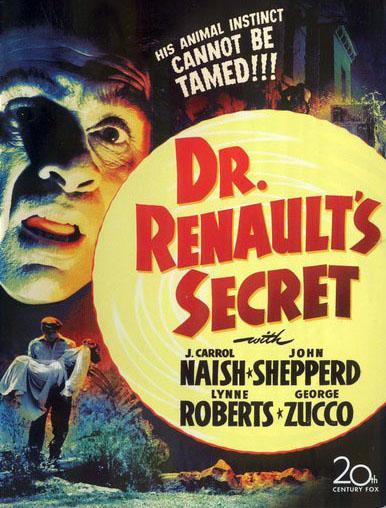 Until the early 2000s this 1942 horror-fest was considered a lost film. Best remembered for having played on a double bill with THE UNDYING MONSTER (1942), the 58-minute DR. RENAULT’S SECRET was a product of Twentieth Century Fox (not exactly a studio known for its horror output). It’s also notable as the only surviving adaptation of Gaston Leroux’s BALAOO, with the others, BALAOO (1913) and THE WIZARD (1927), being MIA in their full versions.
Until the early 2000s this 1942 horror-fest was considered a lost film. Best remembered for having played on a double bill with THE UNDYING MONSTER (1942), the 58-minute DR. RENAULT’S SECRET was a product of Twentieth Century Fox (not exactly a studio known for its horror output). It’s also notable as the only surviving adaptation of Gaston Leroux’s BALAOO, with the others, BALAOO (1913) and THE WIZARD (1927), being MIA in their full versions.
Leroux’s 2012 novel marked the true inception of the public’s early Twentieth Century fascination with malevolent simians. That fascination encompassed classic 1930s films like INGAGI (1930) and KING KONG (1933), and, as DR. RENAULT’S SECRET demonstrates, was still evident in 1942 (yes, I’ve inadvertently given away the “secret” of the title, that an ape-man is involved, but so did the film’s advertising—“His Animal Instinct Cannot Be Tamed!!!”—and DVD synopsis, so I’ll continue to do so in this non-spoiler free review).
Set, ostensibly, in France, DR. RENAULT’S SECRET features the American scientist Larry Forbes (John Shepperd) looking to canoodle with his Gallic fiancée Madeline (Lynne Roberts). She’s the niece of Dr. Renault (George Zucco), a mad scientist who performs unholy experiments on animals with the help of his weird assistant Noel (J. Carroll Naish). The latter, an alleged Javanese immigrant, greets Forbes upon his arrival in France at an inn. There an American hunter, who in a drunken stupor ends up sleeping in Forbes’ room, is strangled to death by an unseen someone.
The following morning Noel drives Forbes to Renault’s chateau, where Madeline is waiting. Noel is undeniably attracted to Madeline, and while trying to woo her with flowers gets viciously attacked by Renault’s dog—which ends up hanged. That Noel is behind the killing, and that of the hunter in the inn, is immediately obvious, and made clear when during a carnival Noel embarks on an all-out killing spree. Forbes is inspired to investigate Renault’s personal papers, in which it’s revealed that Noel is in fact a half-man, half-ape created by the not-so-good doctor.
The director Harry Lachman (1886-1975) was an acclaimed impressionistic painter in addition to a B-movie specialist (in a filmography that includes 1935’s DANTE’S INFERNO, 1936’s THE MAN WHO LIVED TWICE and 1942’s LOVES OF EDGAR ALLAN POE), which explains the artful visuals. Cinematographer Virgil Miller’s use of shadows and low angles (ceilings are more often than not fully visible above the actor’s heads) place the proceedings in film noir territory, and for much of its runtime the film functions more as a noirish mystery than a proper horror product—although certain horrific images (such as a knife-wielding hand emerging from a wall cabinet) and the final revelation make its true orientation clear.
The fact that said revelation is so widely known lessens the suspense considerably, as so much of the narrative is focused on keeping the viewer in the dark about Noel’s true nature. In this sense the film ranks with PSYCHO and THE SIXTH SENSE, and like them suffers from the fact that its major surprise is no longer very surprising.
There are, however, enough good things to warrant a recommendation. As Noel, J. Carroll Naish excels in the type of subhuman role that tended to be played by Karloff or Lugosi. Another standout element is the photography, which places DR. RENAULT’S SECRET in the company of grade-A Golden Age horror fare like MURDERS IN THE RUE MORGUE (1932) and SUPERNATURAL (1933), even if its subject matter is strictly of the B variety.
Vital Statistics
DR. RENAULT’S SECRET
Twentieth Century Fox
Director: Harry Lachman
Screenplay: William Bruckner, Robert F. Meltzer
Cinematography: Virgil Miller
Editing: Fred Allen
Cast: J. Carroll Naish, “John Shepperd” (Shepperd Studwick), Lynne Roberts, George Zucco, Eugene Borden, Bert Roach, Jack Norton, Arthur Shields, Charles Wagenheim, Mike Mazurki, Charles La Torre, Jean Del Val, George Davis, Ed Agresti, Carmen Beretta
